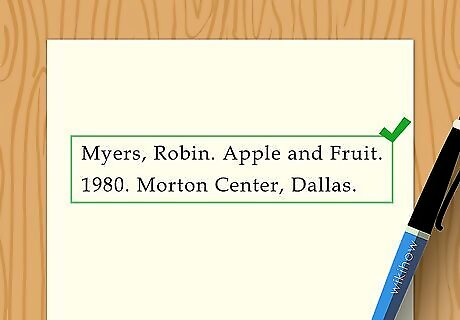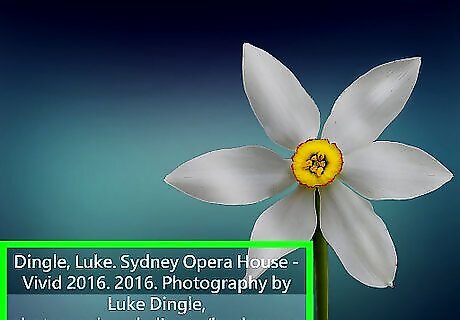
views
Finding the Original Source of an Image

Go to Google image search. In order to properly cite an image, you need to locate the original source. Go to https://images.google.com/?gws_rd=ssl to open the Google image search engine. Another image search engine you can use is called Tineye.

Upload your image and click “search.” Click on the small camera next to the search bar, and select “upload your photo.” Select the photo you’d like to find the original source for from your hard drive, and click search. If you have a URL for the photo, you can search that way too.

Click “view other sizes” to see more results. The initial results you get will only be for images that are the same size as the one you uploaded. Click the link that says “view other sizes” to get a lot more results.

Sort through the results to locate the original. Begin clicking on the images provided and try to find the original source. You may need to do a little sleuthing, and simply use your judgement, to try and find the original owner of the image. There are some clues to look for. The owner of the file is likely to be: The largest size file The oldest file Housed on website that includes copyright info or usage policies

Find the photographer or publisher. Some images are created by photographers or digital designers for profit. These people create images as a way to make a living, and may not want their images used without permission or without the user paying a fee. Do your best to figure out who took the photo or created the image.

Ask for permission to use the image, if necessary. Properly citing an image is an important step, but that alone does not guarantee permission to use or reproduce it. If you plan to use an image on your blog or another published document, seek out the copyright information and usage guidelines for the image. Contact the owner of the image and ask permission to use it. Explain where you’ll be displaying the image and why. In most cases, if you are using the image for educational or non-profit purposes, and if you accurately cite your source, you can use it. If you'll be using the image for commercial purposes, you need to ensure you are following copyright guidelines, and possibly pay a fee for use. Images with creative commons licensing are available for free use.
Gathering Information About an Image

Determine the image creator's name. In order to properly credit an image, you need to gather as much information as you can. Once you’ve located the original source for an image, try to find the name of the person who created it. This could be the name of the person who runs the website where the image is hosted. This could be a username (especially if the image originated on tumblr, pinterest, or other social media sites).

Find out the title of the image. Look for a caption, scroll over the image to see if additional information comes up, or attempt to save the image to see what the file is named.

Determine the date the image was created. If possible, try to determine when the image was created. If the image in question is a representation of an existing artwork or photograph, include the date that the original work was created. If you are working with a web-only image, see if the website hosting the image has information about image usage or copyright. You may be able to find the date of creation there. If you are citing an existing artwork, an internet search should be able to tell you the date of creation.

Figure out where the original is located. If you are citing an artwork, you’ll also need to mention where the original piece is held. List the name of the gallery, library, or museum. Also, list the city where that institution is located. For instance, if you’re talking about Dali’s The Persistence of Memory, a quick internet search will tell you that it is held at the Museum of Modern Art in New York.

Record the place where you accessed the image. Write down the name of the website and/or database where you located the original image. If the website is run by an organization, sponsor, or publisher (such as as a university press), you’ll need to record that info as well.

Record the date when you accessed the image. Materials online are changing all the time. As such, it is important to note the date of access for an image (the date when you saw and/or downloaded it). Including this is not always required, but it helps add credibility to your citation.
Citing Images According to Various Style Guides

Cite the image of artwork in MLA. To cite the image of a piece of artwork in MLA format, provide the artist's name (surname first), the name of the work (italicized), the date of creation, the institution and city where the actual work is located, the name of the website (italicized), the URL, and the date of access. Example: Dali, Salvador. The Persistence of Memory. 1931. Museum of Modern Art, New York. Wikipedia, en.wikipedia.org/wiki/The_Persistence_of_Memory. Accessed 9 Aug 2017.

Use MLA to cite an image that only exists on the web. If the work exists only on the web, the MLA format is a little different. Provide the name of the artist (or username), the title of the work, the name of the website (italicized), the name of the organization behind the website (if any), the date of creation, the URL, and the date of access. You may not be able to find every piece of information, so just include what you can. Example: Hindstrom, Jari. Young Girl Doing Cartwheel at Parade. 123RF, www.123rf.com/photo_14428384_young-girl-doing-cartwheel-at-the-park-with-narrow-depth-of-field.html. Accessed 9 Aug 2017.

Cite an image in APA. To cite an image (artwork or web), you need a lot of the same information, but it’s organized a little differently. You’ll want to include: the artist’s surname, first initial, and middle initial; the year it was made; the title of the artwork and the format (in brackets); and the URL. Example: Dali, S. 1931. The Persistence of Memory [painting]. Museum of Modern Art, New York. Retrieved on August 9, 2017 from Wikipedia, https://en.wikipedia.org/wiki/The_Persistence_of_Memory. Try to find as much information as possible, but just include whatever you can. In some cases, your entry might be as simple as: [Untitled illustration of a banana]. Retrieved August 9, 2017 from http://www.fruit/pix.com.

Use Chicago Style to cite an image. To cite an image (artwork or web) using Chicago Style, you will need the artist’s name, the title of work (italicized), the medium, measurements for the work, and the institution where the piece is located, the URL, and the date you accessed the file. If you are referencing a figure used in an essay, begin your citation with the figure number. Once again, you only need to include the information that is applicable and available. Example: Fig. 5. Dali, Salvador. The Persistence of Memory. 1931, oil painting on canvas, 24 centimeter (9.4 in) × 33 centimeter (13 in), Museum of Modern Art, New York. Available from Wikipedia, http://en.wikipedia.org/wiki/The_Persistence_of_Memory (accessed August 9, 2017).




















Comments
0 comment